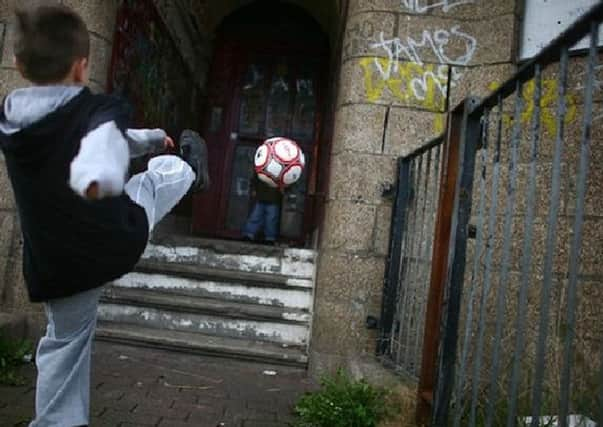Report finds 1 in 5 Scottish children living in poverty


Campaigners and politicians called for action to tackle child poverty following publication of the report, which also showed an increase in the problem in recent years.
According to the 2016 Annual Report for the Child Poverty Strategy in Scotland, the number of children living in relative poverty had risen by 20,000 between 2014-15 and 2013-14.
Advertisement
Hide AdAdvertisement
Hide AdWhen the measure of relative poverty was applied, the number of children to fall in that category had gone up to 160,000 in 2014-15.
The 2014-15 figure was the equivalent of 17 per cent of all children, an increase from 14 per cent recorded the year before.
Relative poverty is defined as the percentage of children living in households with net incomes of less than 60 per cent of the UK average household income.
The report also found that only 9.2 per cent of two to 15-year-olds from the poorest households were eating their five-a-day portions of fruit and vegetables.
Concern about their lifestyles was also caused by the fact that 14.6 per cent of the poorest children spent four or more hours in front of a screen and 10 per cent of the poorest 15-year-olds were regular smokers.
Since 2010 the percentage of poor children who say they are accepted by classmates has fallen from 71.1 per cent to 62.6 per cent.
Last night the Child Poverty Action Group (CPAG), described the level of child poverty as “totally unacceptable” while the Greens said the figures were a scandal.
John Dickie, the CPAG director in Scotland, said: “With a totally unacceptable one in five of Scotland’s children still living in poverty it’s clear government at every level needs to ratchet up commitment to ending that poverty.
Advertisement
Hide AdAdvertisement
Hide Ad“The Scottish Government’s proposed Child Poverty Bill is a vital step toward that – setting out clear ambitions with income-based targets to build on the areas of progress this year’s report highlights.
“It’s now essential that the new bill includes clear duties setting out the role of local government and its partners, and that government has a duty to report to parliament on progress in the years ahead.”
He added that the Scottish Government should use new powers over the benefits system to help ease the problem.
Mr Dickie said: “Eradicating child poverty by 2030 will be challenging and the Holyrood government needs to use every tool in its toolbox. New powers to top up reserved benefits, including child benefit, offer an opportunity to back the new bill with the kind of investment needed if ministers are serious about their ambitions. A £5 a week top-up to child benefit would in itself reduce child poverty by 14 per cent in Scotland.”
Alison Johnstone, social security spokeswoman for the Scottish Greens and MSP for Lothian, said: “To see an increase in child poverty is deeply disturbing, and Scottish ministers should be straining at the limits of their powers to tackle this scandal.”
The report showed a decline in school standards in those from poor backgrounds. The percentage of primary seven pupils from deprived areas who performed well in numeracy fell from 61.4 in 2012 to 54.3. There was a similar decline in writing, with good performances falling from 60.9 per cent to 56.3 per cent.
Equalities secretary Angela Constance acknowledged that it was “simply unacceptable” that children were growing up in poverty in Scotland.
“That’s why tackling the issue is a key priority for this government,” Ms Constance said. “The annual report shows an improvement in a number of areas, which is important as we seek to tackle the deep-rooted causes of child poverty.
“And for those areas where we can do better, we can use this report to help inform our approach and actions.”
